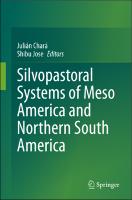| dc.contributor.author | Esquivel Sheik, María J | |
| dc.contributor.author | Finegan, Bryan | |
| dc.contributor.author | Healey, John R | |
| dc.contributor.author | Casanoves, Fernando | |
| dc.date.accessioned | 2023-12-12T15:13:00Z | |
| dc.date.available | 2023-12-12T15:13:00Z | |
| dc.date.issued | 2023 | |
| dc.identifier.uri | https://repositorio.catie.ac.cr/handle/11554/12514 | |
| dc.description.abstract | Species’ natural regeneration capacity is an ecological property of plant communities that is key to restoring diversity after disturbances and to conserving the delivery of related ecosystem services within agroecosystems. Reduced diversity of trees and shrubs promoted by conventional and intensive livestock pastureland management can reduce capacity for natural regeneration of woody vegetation, negatively affecting current and future ecological processes. We evaluate the relationships between the cover of woody species with different plant traits and the abundance of naturally regenerated seedlings and saplings within conventional pastureland management. Four main dimensions of plant traits (leaf, stem density, canopy height and reproductive variability spectra) were measured for the 76 woody species most commonly found within conventionally managed pastureland in the Mesoamerican region. All these plant traits were correlated with species’ abundance and natural regeneration capacity. Under current practices, there is a risk of decrease in functional diversity of woody components and their capacity to deliver ecosystem services due to loss of species with a low regeneration capacity. The development of livestock management strategies, like agroforestry and specifically silvopastoral systems that take into account woody plant traits and natural regeneration management, are important to conserve current and future agro-biodiversity and potential delivery of ecosystem services in agricultural landscapes. | es_ES |
| dc.format.extent | 26 páginas | es_ES |
| dc.language.iso | en | es_ES |
| dc.publisher | Springer Nature | es_ES |
| dc.relation.ispartof | Silvopastoral Systems of Meso America and Northern South America | es_ES |
| dc.relation.uri | https://doi.org/10.1007/978-3-031-43063-3_14 | |
| dc.subject | Plántulas||seedlings||plântula||plantule | es_ES |
| dc.subject | Plantas leñosas||woody plants||planta lenhosa||plante ligneuse | es_ES |
| dc.subject | Dinámica de poblaciones||population dynamics||dinâmica populacional||dynamique des populations | es_ES |
| dc.subject | Sistemas de explotación||farming systems||sistema de exploração agrícola||système d'exploitation agricole | es_ES |
| dc.subject | Regeneración natural||natural regeneration||regeneração natural||régénération naturelle | es_ES |
| dc.subject | Farm trees | es_ES |
| dc.subject | Saplings | es_ES |
| dc.subject | Woody cover | es_ES |
| dc.subject | Agricultural systems | es_ES |
| dc.subject.other | Sede Central | es_ES |
| dc.title | Increasing Biodiversity in Livestock Production Systems: Plant Traits and Natural Regeneration Capacity of Woody Vegetation in Actively Managed Grasslands | es_ES |
| dc.type | Capítulo del libro | es_ES |
| dc.identifier.status | restrictedAccess | es_ES |


